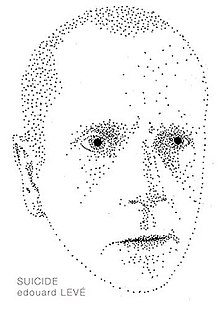This article is about the novel. For the cause of death, see Suicide.
This article has multiple issues. Please help improve it or discuss these issues on the talk page. (Learn how and when to remove these messages)
|
 English edition English edition | |
| Author | Édouard Levé |
|---|---|
| Translator | Jan Steyn |
| Language | French |
| Publisher | Gallimard (French) Dalkey Archive Press (English) |
| Publication date | 2008 |
| Publication place | France |
| Published in English | March 2010 |
| Media type | |
| Pages | 128 |
| ISBN | 978-1-56478-628-9 |
Suicide is a short novel by Édouard Levé noted for its precise language and seemingly random structure meant to imitate human memory.
An excerpt of Suicide titled Life in Three Houses appeared in the April 2011 issue of Harper's.
Plot
The work's prose is a second person narration detailing disconnected episodes about "you", the narrator's friend that committed suicide some twenty years before. The descriptions are never more than a few paragraphs long. They culminate and characterize "you".
After the main body of the work (the prose), there are pages of verse that "your wife" found in "your desk drawer". They are written in first person with the word "me" ending almost every line of each tercet in the English translation.
Major themes
One of the work's major themes is the coherence of a human life. The narrator and "you" see human life as an absurd collection of meaningless events, but "your" suicide gives previously meaningless actions meaning. "Your" suicide organizes "your" life into a coherent narrative. The narrator claims that "your" suicide has actually become the beginning of "your" life story. The book, fittingly, begins by recounting "your" suicide.
Levé's suicide
Much of the analysis and interpretation of Suicide hinges on the fact that ten days after giving the text to his publisher, Levé hanged himself. The book has been interpreted as autobiographical. It has also been viewed as an internal dialogue between the two sides of Levé ("you" and "I").
Throughout the work, Levé ensures "your" motivations for committing suicide are unknown to the narrator and, consequently, the reader. In the book, "you" leave open a comic book to a two-page spread as an explanation of "your" suicide. But, when "your wife" sees "you" dead, she knocks over the comic book. Nobody knows which page "you" thought explained "your" suicide.
Contrastingly, Levé is said to have left a suicide note. Some reviewers say these differences between the book and Levé's own life were meant to separate the book from Levé's own act.
References
- Wilcken, Hugo (8 March 2010). "Happiness, Sadness, Death". The Berlin Review of Books. Archived from the original on 8 November 2011. Retrieved 24 July 2011.
- "Seven questions for translator Jan Steyn on Suicide". conversationalreading.com. Retrieved 22 May 2023.
- Suicide by Edouard Levé, Bookforum. Mentions Levé's idea that suicide creates a coherent narrative for a life.
- "Blogger".
- Salon, Jena (22 February 2011). "On reading Edouard Levé's Suicide". BOMB. Archived from the original on 15 September 2012. Retrieved 24 July 2011.